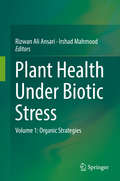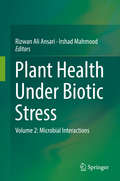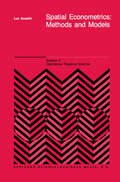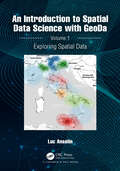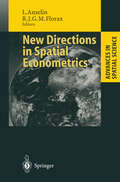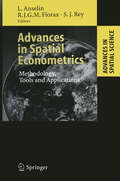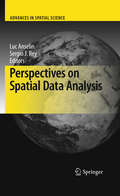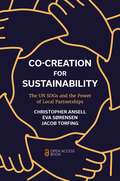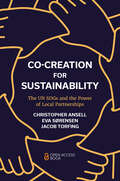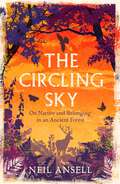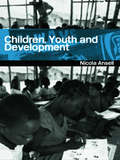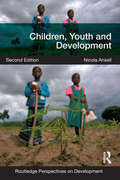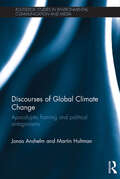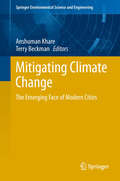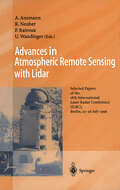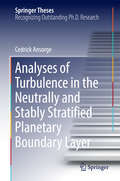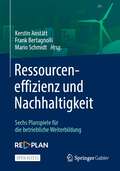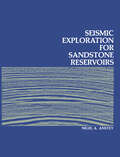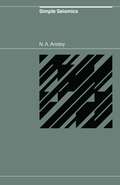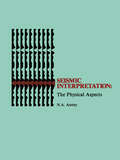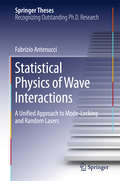- Table View
- List View
Plant Health Under Biotic Stress: Volume 1: Organic Strategies
by Rizwan Ali Ansari Irshad MahmoodThe current scenario of increasing sensitivity towards the sustainable agriculture has given a large space to extensively utilize natural resources that are environmental friendly and are a good replacement of chemicals in agriculture. Application of organic additives in the sustainable disease management can provide new insight in sustenance of plant productivity along with improved host stress tolerance. In the present book we have focussed upon a range of organic strategies to control plant pathogens of wide spectrum in addition to maintaining robust plant health. A detailed account on the application of organic additives has been discussed, irrespective of their origin and nature. In addition, the methods of utilising these organic supplements in the management of plant diseases and promotion of plant yield in more economic way have also been presented with reference to developing, underdeveloped and developed countries. The book has included the works of eminent scholars from across the world thus flashing light on the key literature related to application of organic matters including phytoextracts, chopped leaves, composted organic manures and liquid manures in eco-friendly agriculture. The mechanisms underlying the effectiveness of these organic amendments in promoting plant health has also been presented and discussed in understandable ways.
Plant Health Under Biotic Stress: Volume 2: Microbial Interactions
by Rizwan Ali Ansari Irshad MahmoodThe book illustrates the use of putative microbial agents which provide good protection to the plant from biotic pathogens attack. An up to date knowledge on plant-microbiome interaction strategies in terms of improved sustainability has been discussed. Information from experts across the globe on the application of microbes for providing amicable solution in sustainable agriculture has been gathered. In addition, information related to microbes mediated resistance levels leading to enhanced plant health has been well presented. The chapters have emphasised the use of Plant Growth Promoting Rhizobacteria (PGPR) and other potential biocontrol agents/antagonists in the management of plant diseases which provide extensive information to the readers. Literature on microbial root colonization, plant growth promotions, and also on the protection of plants from attack of various soil borne pathogens have been presented in a coherent way. Information on the application of potential strain of the bio-control fungi, endophytes, actinomycetes strengthening the plants ability which rescue the plant from pathogens attack leading to improved plant health has also been underpinned.
Spatial Econometrics: Methods and Models (Studies in Operational Regional Science #4)
by L. AnselinSpatial econometrics deals with spatial dependence and spatial heterogeneity, critical aspects of the data used by regional scientists. These characteristics may cause standard econometric techniques to become inappropriate. In this book, I combine several recent research results to construct a comprehensive approach to the incorporation of spatial effects in econometrics. My primary focus is to demonstrate how these spatial effects can be considered as special cases of general frameworks in standard econometrics, and to outline how they necessitate a separate set of methods and techniques, encompassed within the field of spatial econometrics. My viewpoint differs from that taken in the discussion of spatial autocorrelation in spatial statistics - e.g., most recently by Cliff and Ord (1981) and Upton and Fingleton (1985) - in that I am mostly concerned with the relevance of spatial effects on model specification, estimation and other inference, in what I caIl a model-driven approach, as opposed to a data-driven approach in spatial statistics. I attempt to combine a rigorous econometric perspective with a comprehensive treatment of methodological issues in spatial analysis.
An Introduction to Spatial Data Science with GeoDa: Volume 1: Exploring Spatial Data
by Luc AnselinThis book is the first in a two-volume series that introduces the field of spatial data science. It offers an accessible overview of the methodology of exploratory spatial data analysis. It also constitutes the definitive user’s guide for the widely adopted GeoDa open-source software for spatial analysis. Leveraging a large number of real-world empirical illustrations, readers will gain an understanding of the main concepts and techniques, using dynamic graphics for thematic mapping, statistical graphing, and, most centrally, the analysis of spatial autocorrelation. Key to this analysis is the concept of local indicators of spatial association, pioneered by the author and recently extended to the analysis of multivariate data.The focus of the book is on intuitive methods to discover interesting patterns in spatial data. It offers a progression from basic data manipulation through description and exploration to the identification of clusters and outliers by means of local spatial autocorrelation analysis. A distinctive approach is to spatialize intrinsically non-spatial methods by means of linking and brushing with a range of map representations, including several that are unique to the GeoDa software. The book also represents the most in-depth treatment of local spatial autocorrelation and its visualization and interpretation by means of GeoDa.The book is intended for readers interested in going beyond simple mapping of geographical data to gain insight into interesting patterns. Some basic familiarity with statistical concepts is assumed, but no previous knowledge of GIS or mapping is required.Key Features:• Includes spatial perspectives on cluster analysis• Focuses on exploring spatial data• Supplemented by extensive support with sample data sets and examples on the GeoDaCenter websiteThis book is both useful as a reference for the software and as a text for students and researchers of spatial data science.Luc Anselin is the Founding Director of the Center for Spatial Data Science at the University of Chicago, where he is also the Stein-Freiler Distinguished Service Professor of Sociology and the College, as well as a member of the Committee on Data Science. He is the creator of the GeoDa software and an active contributor to the PySAL Python open-source software library for spatial analysis. He has written widely on topics dealing with the methodology of spatial data analysis, including his classic 1988 text on Spatial Econometrics. His work has been recognized by many awards, such as his election to the U.S. National Academy of Science and the American Academy of Arts and Science.
An Introduction to Spatial Data Science with GeoDa: Volume 1: Exploring Spatial Data
by Luc AnselinThis book is the first in a two-volume series that introduces the field of spatial data science. It offers an accessible overview of the methodology of exploratory spatial data analysis. It also constitutes the definitive user’s guide for the widely adopted GeoDa open-source software for spatial analysis. Leveraging a large number of real-world empirical illustrations, readers will gain an understanding of the main concepts and techniques, using dynamic graphics for thematic mapping, statistical graphing, and, most centrally, the analysis of spatial autocorrelation. Key to this analysis is the concept of local indicators of spatial association, pioneered by the author and recently extended to the analysis of multivariate data.The focus of the book is on intuitive methods to discover interesting patterns in spatial data. It offers a progression from basic data manipulation through description and exploration to the identification of clusters and outliers by means of local spatial autocorrelation analysis. A distinctive approach is to spatialize intrinsically non-spatial methods by means of linking and brushing with a range of map representations, including several that are unique to the GeoDa software. The book also represents the most in-depth treatment of local spatial autocorrelation and its visualization and interpretation by means of GeoDa.The book is intended for readers interested in going beyond simple mapping of geographical data to gain insight into interesting patterns. Some basic familiarity with statistical concepts is assumed, but no previous knowledge of GIS or mapping is required.Key Features:• Includes spatial perspectives on cluster analysis• Focuses on exploring spatial data• Supplemented by extensive support with sample data sets and examples on the GeoDaCenter websiteThis book is both useful as a reference for the software and as a text for students and researchers of spatial data science.Luc Anselin is the Founding Director of the Center for Spatial Data Science at the University of Chicago, where he is also the Stein-Freiler Distinguished Service Professor of Sociology and the College, as well as a member of the Committee on Data Science. He is the creator of the GeoDa software and an active contributor to the PySAL Python open-source software library for spatial analysis. He has written widely on topics dealing with the methodology of spatial data analysis, including his classic 1988 text on Spatial Econometrics. His work has been recognized by many awards, such as his election to the U.S. National Academy of Science and the American Academy of Arts and Science.
New Directions in Spatial Econometrics (Advances in Spatial Science)
by Luc Anselin Raymond FloraxThe promising new directions for research and applications described here include alternative model specifications, estimators and tests for regression models and new perspectives on dealing with spatial effects in models with limited dependent variables and space-time data.
Advances in Spatial Econometrics: Methodology, Tools and Applications (Advances in Spatial Science)
by Luc Anselin Raymond Florax Sergio J. ReyWorld-renowned experts in spatial statistics and spatial econometrics present the latest advances in specification and estimation of spatial econometric models. This includes information on the development of tools and software, and various applications. The text introduces new tests and estimators for spatial regression models, including discrete choice and simultaneous equation models. The performance of techniques is demonstrated through simulation results and a wide array of applications related to economic growth, international trade, knowledge externalities, population-employment dynamics, urban crime, land use, and environmental issues. An exciting new text for academics with a theoretical interest in spatial statistics and econometrics, and for practitioners looking for modern and up-to-date techniques.
Perspectives on Spatial Data Analysis: Perspectives On Spatial Data Analysis (Advances in Spatial Science)
by Luc Anselin Sergio J. ReySpatial data analysis has seen explosive growth in recent years. Both in mainstream statistics and econometrics as well as in many applied ?elds, the attention to space, location, and interaction has become an important feature of scholarly work. The methodsdevelopedto dealwith problemsofspatialpatternrecognition,spatialau- correlation, and spatial heterogeneity have seen greatly increased adoption, in part due to the availability of user friendlydesktopsoftware. Throughhis theoretical and appliedwork,ArthurGetishasbeena majorcontributing?gureinthisdevelopment. In this volume, we take both a retrospective and a prospective view of the ?eld. We use the occasion of the retirement and move to emeritus status of Arthur Getis to highlight the contributions of his work. In addition, we aim to place it into perspective in light of the current state of the art and future directions in spatial data analysis. To this end, we elected to combine reprints of selected classic contributions by Getiswithchapterswrittenbykeyspatialscientists.Thesescholarswerespeci?cally invited to react to the earlier work by Getis with an eye toward assessing its impact, tracing out the evolution of related research, and to re?ect on the future broadening of spatial analysis. The organizationof the book follows four main themes in Getis’ contributions: • Spatial analysis • Pattern analysis • Local statistics • Applications For each of these themes, the chapters provide a historical perspective on early methodological developments and theoretical insights, assessments of these c- tributions in light of the current state of the art, as well as descriptions of new techniques and applications.
Co-Creation for Sustainability: The UN SDGs and the Power of Local Partnerships
by Christopher Ansell Eva Sørensen Jacob TorfingThe ebook edition of this title is Open Access and freely available to read online. The UN’s Sustainable Development Goals (SDGs) set an ambitious agenda for global problem-solving and create a framework to achieve it through the power of partnerships. Goal 17 points to the central importance of partnerships, networks, and multi-stakeholder collaborations for bringing together a broad range of actors to accomplish the first 16 goals. Only through such partnerships can the distributed knowledge, resources and capacity of government agencies, private enterprises, political activists, local communities, and international NGOs be effectively combined to produce the major breakthroughs in sustainability that the SDGs envision. Co-Creation for Sustainability sets out a strategy of partnership, with an emphasis on how global goals can be translated into local action. Co-creation brings multiple parties together—including citizens—to collaboratively engage in innovative problem-solving. The book explains this strategy and describes how to foster the conditions necessary for its success. It details how leaders can spur co-creation and manage and overcome its practical challenges. Written to inspire public and private changemakers to find fundamental solutions to the pressing challenges that confront our social and natural environment, Co-creation for Sustainability: The UN SDGs and the Power of Partnerships provides intellectual resources and practical advice relevant for those who aspire to harness the talents, energy and perspectives of different sectors to build the momentum we need to realize a sustainable future.
Co-Creation for Sustainability: The UN SDGs and the Power of Local Partnerships
by Christopher Ansell Eva Sørensen Jacob TorfingThe ebook edition of this title is Open Access and freely available to read online. The UN’s Sustainable Development Goals (SDGs) set an ambitious agenda for global problem-solving and create a framework to achieve it through the power of partnerships. Goal 17 points to the central importance of partnerships, networks, and multi-stakeholder collaborations for bringing together a broad range of actors to accomplish the first 16 goals. Only through such partnerships can the distributed knowledge, resources and capacity of government agencies, private enterprises, political activists, local communities, and international NGOs be effectively combined to produce the major breakthroughs in sustainability that the SDGs envision. Co-Creation for Sustainability sets out a strategy of partnership, with an emphasis on how global goals can be translated into local action. Co-creation brings multiple parties together—including citizens—to collaboratively engage in innovative problem-solving. The book explains this strategy and describes how to foster the conditions necessary for its success. It details how leaders can spur co-creation and manage and overcome its practical challenges. Written to inspire public and private changemakers to find fundamental solutions to the pressing challenges that confront our social and natural environment, Co-creation for Sustainability: The UN SDGs and the Power of Partnerships provides intellectual resources and practical advice relevant for those who aspire to harness the talents, energy and perspectives of different sectors to build the momentum we need to realize a sustainable future.
The Circling Sky: On Nature and Belonging in an Ancient Forest
by Neil AnsellFrom a 2018 Wainwright Prize shortlisted author, THE CIRCLING SKY is part childhood memoir, blended with exquisite nature observation, and the story of one man's journey over a year to one of the UK's key natural habitats, the New Forest of HampshireIn the form of several journeys, beginning in January 2019, Neil Ansell returns for solitary walks to the New Forest in Hampshire, close to where he was born. With beautiful sightings and observations of birds, trees, butterflies, insects and landscape, this is also a reflective memoir on childhood, on the history of one of the most ancient and important natural habitats in the United Kingdom, and on the Gypsies who lived there for centuries - and were subsequently expelled to neighbouring cities. It is also part polemic on our collective and individual responsibility for the land and world in which we live, and how we care for it. As Neil Ansell concludes so eloquently, 'Evolution has no choice in what it does, but we do, as a species, if not always as individuals'.
Children, Youth and Development
by Nicola AnsellChildren constitute a large part of the population of developing countries. Throughout the developing world, experiences of childhood are extremely diverse, both between places and between children in particular places, from the international level through to the different treatment of a boy and a girl within the same household. This informative book considers issues such as education, child labour, street children, child soldiers, refugees, child slaves, the impact of environmental change and hazards on children and the way that children, with the enthusiasm and energy to bring about change, can be enabled to participate in 'development'.
Children, Youth and Development
by Nicola AnsellChildren constitute a large part of the population of developing countries. Throughout the developing world, experiences of childhood are extremely diverse, both between places and between children in particular places, from the international level through to the different treatment of a boy and a girl within the same household. This informative book considers issues such as education, child labour, street children, child soldiers, refugees, child slaves, the impact of environmental change and hazards on children and the way that children, with the enthusiasm and energy to bring about change, can be enabled to participate in 'development'.
Children, Youth and Development (Routledge Perspectives on Development)
by Nicola AnsellThe new updated edition of Children, Youth and Development explores the varied ways in which global processes in the form of development policies, economic and cultural globalisation, and international agreements interact with more locally specific practices to shape the lives of young people living in the poorer regions of the world. It examines these processes, and the effects they have on young people’s lives, in relation to developing theoretical approaches to the study of children and youth.? This landmark title brings together the stock of knowledge and approaches to understanding young people’s lives in the context of development and globalization in the majority world for the first time. It introduces different theoretical approaches to the study of young people, and explores the ways in which these, along with predominantly Western conceptions of childhood and youth, have influenced how majority world children have been viewed and treated by international agencies. Contexts of globalisation and growing international inequality are explored, alongside more immediate contexts such as family and peer relationships. Chapters are devoted to groups of children deemed to be in need of protection and to debates concerning children’s rights and their participation in development projects. Young people’s health and education are considered, as is their involvement in work of various kinds, and the impacts of environmental change and hazards (including climate change). The book introduces material and concepts to readers in a very accessible way and within each chapter employs features such as boxed case studies, summaries of key ideas, discussion questions and guides to further resources. This edition has been updated to take account of significant changes in the contexts in which poor children grow up, notably the financial crisis and changing development policy environment, as well as recent theoretical developments. It is aimed at students on higher level undergraduate and postgraduate courses, as well as researchers who are unfamiliar with this area of research and practitioners in organisations working to ameliorate the lives of children in majority world countries.
Children, Youth and Development (Routledge Perspectives on Development)
by Nicola AnsellThe new updated edition of Children, Youth and Development explores the varied ways in which global processes in the form of development policies, economic and cultural globalisation, and international agreements interact with more locally specific practices to shape the lives of young people living in the poorer regions of the world. It examines these processes, and the effects they have on young people’s lives, in relation to developing theoretical approaches to the study of children and youth.? This landmark title brings together the stock of knowledge and approaches to understanding young people’s lives in the context of development and globalization in the majority world for the first time. It introduces different theoretical approaches to the study of young people, and explores the ways in which these, along with predominantly Western conceptions of childhood and youth, have influenced how majority world children have been viewed and treated by international agencies. Contexts of globalisation and growing international inequality are explored, alongside more immediate contexts such as family and peer relationships. Chapters are devoted to groups of children deemed to be in need of protection and to debates concerning children’s rights and their participation in development projects. Young people’s health and education are considered, as is their involvement in work of various kinds, and the impacts of environmental change and hazards (including climate change). The book introduces material and concepts to readers in a very accessible way and within each chapter employs features such as boxed case studies, summaries of key ideas, discussion questions and guides to further resources. This edition has been updated to take account of significant changes in the contexts in which poor children grow up, notably the financial crisis and changing development policy environment, as well as recent theoretical developments. It is aimed at students on higher level undergraduate and postgraduate courses, as well as researchers who are unfamiliar with this area of research and practitioners in organisations working to ameliorate the lives of children in majority world countries.
Discourses of Global Climate Change: Apocalyptic framing and political antagonisms (Routledge Studies in Environmental Communication and Media)
by Jonas Anshelm Martin HultmanThis book examines the arguments made by political actors in the creation of antagonistic discourses on climate change. Using in-depth empirical research from Sweden, a country considered by the international political community to be a frontrunner in tackling climate change, it draws out lessons that contribute to the worldwide environmental debate. The book identifies and analyses four globally circulated discourses that call for very different action to be taken to achieve sustainability: Industrial fatalism, Green Keynesianism, Eco-socialism and Climate scepticism. Drawing on risk society and post-political theory, it elaborates concepts such as industrial modern masculinity and ecomodern utopia, exploring how it is possible to reconcile apocalyptic framing to the dominant discourse of political conservatism. This highly original and detailed study focuses on opinion leaders and the way discourses are framed in the climate change debate, making it valuable reading for students and scholars of environmental communication and media, global environmental policy, energy research and sustainability.
Discourses of Global Climate Change: Apocalyptic framing and political antagonisms (Routledge Studies in Environmental Communication and Media)
by Jonas Anshelm Martin HultmanThis book examines the arguments made by political actors in the creation of antagonistic discourses on climate change. Using in-depth empirical research from Sweden, a country considered by the international political community to be a frontrunner in tackling climate change, it draws out lessons that contribute to the worldwide environmental debate. The book identifies and analyses four globally circulated discourses that call for very different action to be taken to achieve sustainability: Industrial fatalism, Green Keynesianism, Eco-socialism and Climate scepticism. Drawing on risk society and post-political theory, it elaborates concepts such as industrial modern masculinity and ecomodern utopia, exploring how it is possible to reconcile apocalyptic framing to the dominant discourse of political conservatism. This highly original and detailed study focuses on opinion leaders and the way discourses are framed in the climate change debate, making it valuable reading for students and scholars of environmental communication and media, global environmental policy, energy research and sustainability.
Mitigating Climate Change: The Emerging Face of Modern Cities (Springer Environmental Science and Engineering)
by Anshuman Khare and Terry BeckmanWith ever increasing trends in urban consumption and production practices, a call for action to mitigate Climate Change is often seen as a way to foster sustainable development. Considerable attention is now being paid to determine what urban sustainability would include. Today there is a pressing need to broaden our knowledge and apply new concepts and frameworks to development of modern cities. Building on the foregoing, this book attempts to bring together and discuss concepts, tools, frameworks and best practices to cope with the emerging challenges faced by cities today. The book will be of use to policy makers, city planners, practitioners and academics who are starting to project what modern cities would need to do in terms of energy efficiency, mobility, planning and design of habitat and infrastructure and adapting to climate change.
Advances in Atmospheric Remote Sensing with Lidar: Selected Papers of the 18th International Laser Radar Conference (ILRC), Berlin, 22–26 July 1996
by Albert Ansmann Roland Neuber Patrick Rairoux Ulla WandingerLidar or laser radar, the depth-resolved remote measurement of atmospheric parameters with optical means, has become an important tool in the field of atmospheric and environmental remote sensing. In this volume the latest progress in the development of Lidar methods, experiments, and applications is described. The content is based on selected and thoroughly refereed papers presented at the 18th International Laser Radar Conference, Berlin, 22 - 26 July 1996. The book is divided into six parts which cover the topics of tropospheric aerosols and clouds, Lidar in space, wind, water vapor, troposheric trace gases and plumes, and stratospheric and mesospheric profiling. As a supplement to fundamental LIDAR textbooks this volume may serve as a guide through the blossoming field of modern Lidar techniques.
Analyses of Turbulence in the Neutrally and Stably Stratified Planetary Boundary Layer (Springer Theses)
by Cedrick AnsorgeThis thesis presents a study of strong stratification and turbulence collapse in the planetary boundary layer, opening a new avenue in this field. It is the first work to study all regimes of stratified turbulence in a unified simulation framework without a break in the paradigms for representation of turbulence. To date, advances in our understanding and the parameterization of turbulence in the stable boundary layer have been hampered by difficulties simulating the strongly stratified regime, and the analysis has primarily been based on field measurements. The content presented here changes that paradigm by demonstrating the ability of direct numerical simulation to address this problem, and by doing so to remove the uncertainty of turbulence models from the analysis. Employing a stably stratified Ekman layer as a simplified physical model of the stable boundary layer, the three stratification regimes observed in nature— weakly, intermediately and strongly stratified—are reproduced, and the data is subsequently used to answer key, long-standing questions. The main part of the book is organized in three sections, namely a comprehensive introduction, numerics, and physics. The thesis ends with a clear and concise conclusion that distills specific implications for the study of the stable boundary layer. This structure emphasizes the physical results, but at the same time gives relevance to the technical aspects of numerical schemes and post-processing tools. The selection of the relevant literature during the introduction, and its use along the work appropriately combines literature from two research communities: fluid dynamics, and boundary-layer meteorology.
Ressourceneffizienz und Nachhaltigkeit: Sechs Planspiele für die betriebliche Weiterbildung
by Kerstin Anstätt Frank Bertagnolli Mario SchmidtKlimaschutz und Ressourceneffizienz gehen häufig Hand in Hand. Mit Spiel und Spaß ressourceneffizientes Handeln fördern – das ist die Devise der Planspiele rund um das Thema Energie- und Materialeffizienz, die in diesem Buch vorgestellt werden. Die Planspiele schließen eine Lücke im betrieblichen Weiterbildungsangebot und bilden ein niederschwelliges Angebot, mit dem ressourceneffizientes Denken und Handeln spielerisch in Unternehmen eingeführt werden kann. Unternehmen aller Art können gleich auf mehrere Arten von den in den Spielen vermittelten Kenntnissen und Methoden profitieren: Durch Ressourceneffizienz-Maßnahmen werden sowohl deutliche Kosteneinsparungen erzielt als auch ein Beitrag zum Klimaschutz durch die Minderung von Treibhausgasemissionen geleistet. Dies wirkt sich nicht zuletzt positiv auf die Wettbewerbs- und die Innovationsfähigkeit aus. Darüber hinaus werden die Mitarbeiter intern mit einem attraktiven und kurzweiligen Schulungsangebot weiterqualifiziert. Die Interaktion im Spiel involviert die Mitarbeiter aktiv und motiviert sie, ihr Wissen produktiv einzubringen. Das Ergebnis sind neue Ideen für noch mehr Effizienz im Unternehmen und gleichzeitig für mehr Klimaschutz. In diesem Open Access-Buch werden sowohl das fachliche Hintergrundwissen für die in den Spielen vermittelten Methoden beschrieben als auch konkrete Anleitungen zur Durchführung der Spiele gegeben.
Seismic Exploration for Sandstone Reservoirs
by N.A. AnsteyThis text was originally written for use with the videotape program of the same title. Numbered video cassettes correspond to the following chapters of the book: Tape Chapter(s) Tape Chapter(s) 1 1-2. 2. 1 11 3. 4 2 2. 2. 2-2. 3 12 3. 5. 1-3. 5. 2 3 2. 4 13 3. 5. 3 4 2. 5-2. 6 14 3. 5. 4-3. 6. 3 5 2. 7-2. 8 15 3. 7-3. 7. 2 6 3 16 3. 8-4 7 3. 1 17 4. 1 8 3. 2-3. 2. 1 18 4. 2-4. 4 9 3. 2. 2-3. 2. 3 19 5 10 3. 3 Complete information about the videotape program, Seismic Exploration for Sandstone Reservoirs may be obtained from: IHRDC, 137 Newbury St. , Boston, MA 02116, (617) 536-0202. Acknowledgements Thanks are expressed to the authors, companies and professional associations who have allowed the use of their material in the course. The author and publisher are grateful for permission to reproduce material whose copyright belongs as follows: Figures: 2. 4-3 (Widess) SEG; 2. 4-4 (Prescott) Continental Oil Company; 3-1 (Le Blanc) AAPG; 3-2 (MacKenzie) AAPG; 3. 1-1 Seiscom Delta; 3. 1-3 (Schramm et al. ) AAPG; 3. 1-4 (Lamer et al. ) Western Geophysical Company; 3. 2. 2-2 Prakla Seismos; 3. 2. 2-3 (Leung et al. ) Amoco Europe; 3. 2. 2-4 (Newman et al. ) S&A Geophysical; 3. 2. 3-2 Seiscom Delta; 3. 3-1 (Taner) Seiscom Delta; 3.
Simple Seismics for the petroleum geologist, the reservoir engineer, the well-log analyst, the processing technician, and the man in the field
by N.A. AnsteyThis little book is different. It is written, primarily, for geologists, reservoir engineers, and log analysts. Why? Because today's seismic method is more than a tool for reconnaissance exploration, for finding structures; it has become a tool for studying the discovered reservoir-its extent, its barriers, its variations of thickness, and its trends of porosity. Today, the geophysicist, the geolog ist, the engineer, and the log analyst can do great things together. Because the book is not written primarily for geophysi cists, it can skip much of the "mechanics" of the seismic method. The reader who reaches the last page (bless him!) will not be able to practise the seismic method, but he will understand how the seismic method can help to solve his problems. It may also be of value to those practitioners of the seismic method-in the field or in the processing centre-who already know the mechanics of the method, but would like to take a broader view. 1 1 Seismics and Structure Of all the geophysical methods working from the surface, there is only one which is widely accepted for studies of individual petroleum reservoirs-the seismic reflection method. We would dearly love to have something better, but alas ... Reduced to its essentials, the method is this: we make a bang, and we listen for echoes.
Seismic Interpretation: The Physical Aspects
by Nigel A. AnsteyIn this course we shall assume that all participants are familiar with the essentials of seismic prospecting. Thus A the rudiments of the field work -- spreads, sources, arrays B and digital recording -- are assumed known. So also are the C rudiments of processing -- such processes as gain recovery, D filtering, deconvolution, velocity analysis, and display. E Just as important, we shall assume that all participants F have some feeling for the realities of seismic work -- in the l(B) field, under real conditions. Elementary signal theory and the basic techniques of interpretation are also assumed known. However, for certainty, the following pre-course notes include sections reviewing basic signal theory, geophysical aspects of interpretation, and geological aspects of interpretation. These reviews are not intended to be comprehensive. Their function is solely to cover, with the minimum possible discussion, the essential features which will be assumed to be known in the course. None of the course time will be spent on the material of these pre-course notes. Participants are advised that they will not derive full benefit from the course if this background is not known. Most course participants will be already familiar with this material, and will need to do little more than read it through. If, before the course, any participant requires further discussion of signal theory in the same non-rigorous style, he will find it in other writings of the present author, particularly: "Wiggles", Journal of the CSEG, December 1965, pp.l3-43.
Statistical Physics of Wave Interactions: A Unified Approach to Mode-Locking and Random Lasers (Springer Theses)
by Fabrizio AntenucciThis thesis reveals the utility of pursuing a statistical physics approach in the description of wave interactions in multimode optical systems. To that end, the appropriate Hamiltonian models are derived and their limits of applicability are discussed. The versatility of the framework allows the characterization of ordered and disordered lasers in open and closed cavities in a unified scheme, from standard mode-locking to random lasers. With the use of replica method and Monte Carlo simulations, the models are categorized on the basis of universal properties, and nontrivial predictions of experimental relevance are obtained. In particular, the approach makes it possible to nonperturbatively treat the interplay between disorder and nonlinearity and to envisage novel and fascinating physical phenomena such as glassy random lasers, providing a novel way to experimentally investigate replica symmetry breaking.
